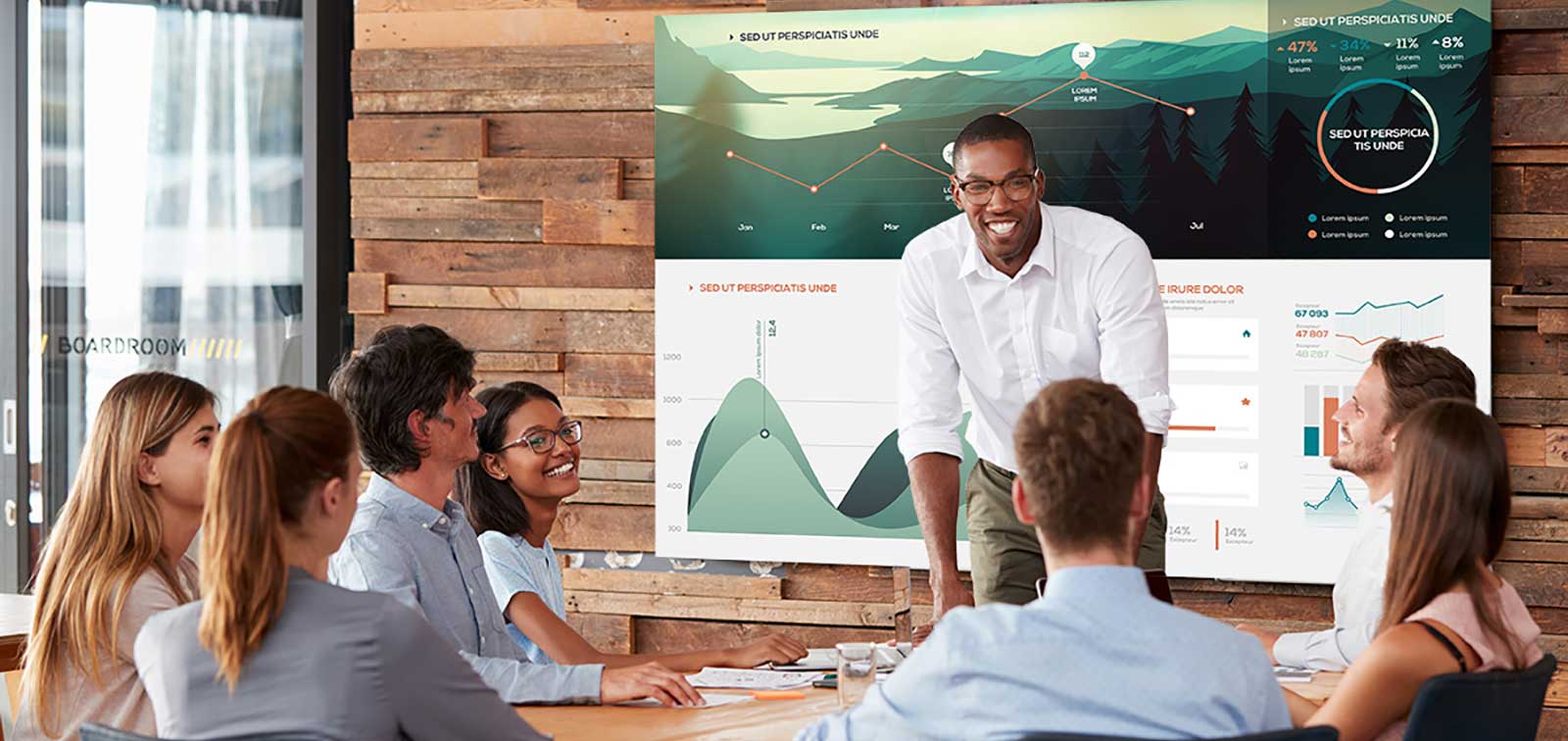
Maybe not an age-old question, but one that people who need to put on effective presentations need to answer “When should I choose projection or flat panel displays?” Both display technologies have their uses, but there are several important considerations — purpose, audience size and positions, image size, visibility, affordability, portability, and convenient setup and removal — that compel presenters and professional installers to decide which display technology serves them best.
Purpose
First off, what is the purpose of the presentation? Is the material highly detailed? Are images critical to the presentation? Since projectors ensure large displays of images and text, presenters are assured their audiences receive the presentation as clearly and legibly as possible. Flat panels can be a great option in interactive environments, like classrooms, think tanks and other shared spaces.
Audience size
Whether you’re presenting to an audience in a classroom or an auditorium, the audience size and how they’ll be viewing the presentation influences the type of display a presenter should choose. Projectors allow for more flexible placement than those of flat panels as well as a variable screen size so an audience of one to one hundred can easily be accommodated by the same projector. Flat panels provide interactive collaboration for smaller audience sizes and are ideal for classrooms and conference rooms.
Image size
Another consideration for determining the visual solution needed is image size. If images require a 40- to 90-inch diagonal, then a flat panel will suffice. However, if the image needs to be on a 100-inch diagonal screen or appear on curved surfaces, projection is preferable.
You may have noticed this kind of use in retail environments as projected images are perfect for eye-grabbing digital signage. For example, a retailer wanting to stretch an image 125 feet along an extensive back wall can install a projector in the ceiling that projects the image downward upon the wall. A comparable flat panel setup would require an extensive setup – and a higher budget.
Visibility
Flat panels’ glass creates glare absent in projected images, unless equipped with an anti-glare coating, like our Optoma Creative Touch IFP line up. Another advantage projectors provide are an enhanced fill factor, resulting in smoother images. The better visibility inherent in projected images captures and holds audience members’ attention and ensures memorability.
Interactivity
Collaborative work or education environments that require writing, drawing, annotations or other interactive capabilities can opt for either projector or flat panel. Optoma Creative Touch IFPs provide interactivity in 65-inch, 75-inch and 86-inch display sizes. Projectors can provide interactivity, too. The Optoma Creative Touch PCT-101 projected capacitive touch screen provides 101 inches of 30-point multi-touch capabilities when paired with an ultra short throw projector, like the Optoma ZH420UST.
Affordability
Money still does not grow on trees – therefore whether an option is affordable is always a consideration for any application. On an inch-by-inch comparison, projectors can give you more image per dollar, especially with their flexibility to project onto screens of more than 100 inches.
Easy setup and portability
A system’s portability factors in, too. Despite the advent of thinner flat panel displays in the last few years, shipping and logistics are more complicated for flat panel displays. Transporting large flat panel displays and their associated stands and mounts, whether to in-house, in-town or out-of-town venues, is challenging and expensive. Oppositely, presenters need only carry a projector to present stunning images to audiences at any site.
Projectors
The advantages projectors provide for presenters are numerous—better outcomes for purposes, more flexibility surrounding audience sizes and positions, larger and more detailed images, superior visibility, greater affordability and durability, easier portability and more convenient setup and removal.
Flat Panels
Interactivity, collaboration and smaller screen sizes are where flat panels have advantages. All-in-one solutions, like the Optoma Creative Touch interactive flat panels provide a single unit with built-in Android OS, annotation, collaboration and mobile sharing features without additional hardware.
Image and Article Source
https://www.optoma.com/us/why-choose-a-projector-instead-of-a-flat-panel/

Free ground shipping on orders all $99 and up.

We are an authorized dealer for every brand we sell.

Special pricing for preffered customers and dealers.

We are projector experts, with over 20 years of service.

From projectors to projection screens, digital signage to gaming equipment, PSSAV is Your number one source for audio visual equipment. over 200 top brands including Sony, Nec, Epson, Optoma, Benq, Chief, Dalite, Viewsonic, LG and more..
